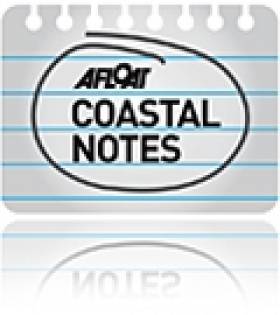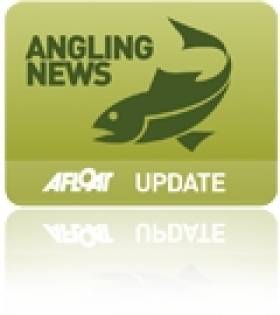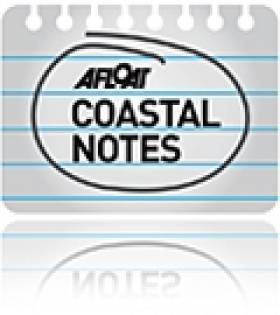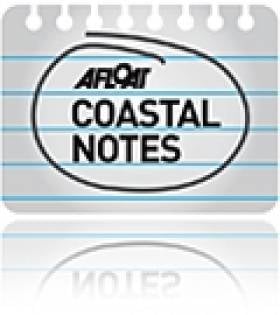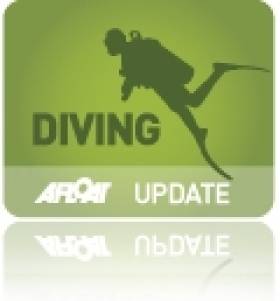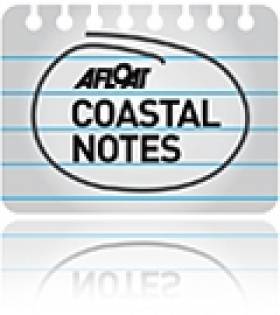Displaying items by tag: Coastal Notes
Surfers To Clash With Council Over Doolin Development
#DOOLIN PIER - The Irish Times reports that surfers will be at loggerheads with Clare County Council this week over controversial plans to redevelop Doolin Pier.
The €8 million plans for the Clare coastal village have been delayed for some time, and have already cost the council more than €250,000.
As previously reported on Afloat.ie, the development was backed unanimously by Clare councillors in March 2011 after revisions made following concerns from local surfers about its impact on popular waves in the area.
However, the Irish Surfing Association (ISA) maintained that even that revised plan would result in the elimination of the waves at Doolin Point and Crab Island - the latter described as Ireland's answer to the Pipeline in Hawaii.
The proposed new pier would serve the 70,000 passengers that use the ferry service between Doolin and the Aran Islands. The development is also supported by the Doolin unit of the Irish Coast Guard, which hopes to get a new coastguard station as part of development plans for the area.
Rare Finds in 25th Anniversary Coastwatch Survey
#COASTAL NOTES - The remains of a leatherback turtle were among the finds reported by 'citizen scientists' taking part in the Coastwatch survey of Ireland's coastline, according to The Irish Times.
As previously reported on Afloat.ie, the 'eco audit' marked the 25th anniversary of the first nationwide Coastwatch survey, taking in use of land and shore, quality of inflow water, waste and pollution, and selected coastal and marine wildlife and plantlife.
The survey period concluded at the weekend with an event at the new Tralee Bay Wetlands centre attended by Minister for Heritage Jimmy Deenihan, close to one of the rare discoveries by survey volunteers in the shape of honeycomb worm reefs.
The Irish Times has more on the story HERE.
Ireland to Get First 'Energy Bank' Beneath NI Lough
#COASTAL NOTES - The first ever 'energy bank' on this island will be constructed deep beneath a coastal lough in Northern Ireland, as the Irish Independent reports.
Some 500 million cubic metres of gas are set to be stored in salt caverns a mile under Larne Lough on the north Antrim coast, after NI Environment Minister Alex Attwood have his go-ahead for the project earlier today.
The Belfast Telegraph reports that site preparation work will begin before the end of this year on the expected seven-year construction scheme.
The €492.5-million gas storage facility is expected to hold a 60-day supply to create a buffer against increasing energy price rises.
"This security of supply of energy will be a significant step forward in the way we manage our energy sector," said Minister Attwood. "North Sea gas supplies are declining steeply and this facility will make a significant contribution to the security of gas supplies for the whole island of Ireland and indeed for Britain."
Meanwhile, environmentalists have voiced concerns over the planned disposal of salt from the caverns into the sea, and its potential to cause harm to marine wildlife and biodiversity.
Though Minister Attwood said he was conscious of environmental concerns, James Orr of Friends of the Earth argued that the dumping of hypersaline salt solution "will kill or be seriously detrimental to the development of larval stages of fish and crustaceans", and that Northern Ireland should rather be investing in renewable energy.
The Belfast Telegraph has more on the story HERE.
Welsh and Irish Ministers Check Out Celtic Sea Trout Project
#ANGLING - Sea trout were top of the agenda at a recent meeting between Welsh Deputy Fisheries Minister Alun Davies and Minister of State Fergus O’Dowd at Leinster House recently.
Both ministers were briefed about progress with the INTERREG IVa Ireland-Wales-funded Celtic Sea Trout Project, which finishes in 2013.
Sea trout are present in most coastal rivers discharging into the Irish Sea, and their status in freshwater and in the marine environment is central to the project.
By providing detailed information about the status of sea trout stocks, their genetics and their varied life histories, the project aims to enhance the fisheries for the benefit of all stakeholders.
Other important aims of the project are strengthening the contribution of sea trout to rural economies, to general quality of life and well-being and to national biodiversity - while sea trout life history variation may also contribute to understanding the effects of climate change.
For sustainable management the Celtic Sea Trout Project team is working on developing a number of management tools which will assist fisheries managers to assess fishery performance and better manage this valuable species. The requirement to manage sea trout sustainably across the Irish Sea was strongly emphasised.
Both ministers heard that engagement with anglers across the project has been important to provide sea trout scale samples, and that the project has served to increase awareness of the value of what Inland Fisheries Ireland (IFI) described as "this excellent angling species".
Minister Davies was also briefed about the role and broad responsibilities of IFI.
'Surfers Against Sewage' Tour Hits Northern Ireland Next Week
#COASTAL NOTES - Surfers Against Sewage will be taking their environmental education programme to Northern Ireland next week, as online surfing magazine Drift reports.
The team are set to visit up to 15 schools, universities, youth groups and sports clubs in coastal communities across Scotland and Northern Ireland in a whistle-stop five-day tour from 1-15 October.
The sessions will give all involved information on the threats facing their local beaches and coastlines from littering and pollution, and what action students can take against them.
Lessons cover Surfers Against Sewage's campaigns on sewage pollution, marine litter, climate change, toxic chemicals, shipping and wave protection - and feature and interactive environmental board game called Marineopoly where students can put into practice what they've learned.
Drift has more on the story HERE.
New Targets for Oil Exploration Off Southwest Coast
#COASTAL NOTES - Oil exploration company Petrel Resources has identified a number of new targets off the southwest coast of Ireland as it seeks bigger partners for its venture.
The Irish Times reports that the Dublin-based firm was awarded licensing options over 1,400 sq km of the Porcupine Basin or Porcupine Blight in the Atlantic Ocean, west of Dursey Island in Co Kerry.
It has since completed two phases of work in the area, and says technical studies of its blocks in the northern and eastern parts of the basin, where is is testing for the presence of reservoir sands, were "encouraging".
The announcement comes following the success of Providence Resources' prospect in the Celtic Sea off the south coast.
As previously reported on Afloat.ie, the Barryroe field may deliver in excess of 2 billion barrels of oil, a flow expected to be worth billions of euro to the Irish economy in future years.
The Irish Times has more on the story HERE.
Public Urged to Join Coastwatch Survey
#COASTAL NOTES - Coastwatch is appealing to the public to get involved in a country-wide 'eco audit' of Ireland's shoreline.
The Irish Times reports that the survey marks the 25th anniversary of the first Coastwatch audit of the coastline of the island of Ireland.
Coastwatch's latest survey got under way this week. It takes in use of land and shore, quality of inflow water, waste and pollution, and selected coastal and marine wildlife and plantlife.
Co-ordinator Karin Dubsky said: "This is citizen science which empowers people and is relevant locally and internationally to improve coastal zone management, highlight issues and implement the new EU marine directive."
The survey and guide notes can be downloaded by anyone from the Coastwatch website, and completed questionnaires can be submitted by post or online.
NUI Galway Hosts Talk on Historical Wreck Diving in Ireland
#DIVING - The Sub-Aqua Club at NUI Galway and the Galway-Mayo Institute of Technology welcomes diving expert Edward Bourke to the NUI Galway campus on 18 October to give a talk on historical wreck diving in Ireland.
The talk will take a look at some of the exploits of wreck and salvage dives in Ireland over the years, exploring the nation of the Irish coast as a hotbed of pioneering subaquatic activity, driven mostly by the recovery of shipborne cannons - not only because of their expense, but also to prevent their falling into the hands of insurgents.
Bourke will give his talk at the Siobhán McKenna Theatre in the Arts Millennium Building at 7pm on Thursday 10 October. The evening will be of interest to local historians and divers alike. And as much of the activity was on the west coast, there is some local maritime interest, too.
Edward Bourke is a microbiologist, maritime historian and diver with Viking Sub Aqua in Dublin for 30 years and has dived in Australia, South Africa, Spain, Croatia, France and UK as well as Ireland. He has published three volumes on Shipwrecks of the Irish Coast, cataloguing some 6,000 wrecks in Irish waters, as well as a book of Irish shipwreck photos and a volume on the wreck of the Tayleur at Lambay Island. A scientist with Diageo, Bourke's most recent publication is a history of Guinness.
Barryroe Oil Field May Hold Further Resources Says Study
#COASTAL NOTES - The Barryroe field off the south coast of Cork may deliver even more oil than previously anticipated, according to the latest surveys.
The Irish Times reports that Providence Resources has completed an evaluation of its Celtic Sea prospect which indicates that the Lower Wealden and Purbeckian areas could hold an "encouraging" yield of 778 million barrels.
The oil firm's tectnical director told the paper that the focus would remain on the Middle and Basal Wealden sands following its appraisal wells drilled over the spring and summer.
As previously reported on Afloat.ie, seismic data and results from six test wells on the Barryroe site led experts to estimate that the oil field contains as much as 1.6 billion barrels in total - four times as much as previous projections.
The oil flow is expected to be worth billions of euro to the Irish economy over a number of years.
The latest news "further reinforces the prospectivity of the area" according to Davy Stockbrokers, who added that "it also suggests that Barryroe will not be the only development of Purbeckian oil in the Celtic Sea".
Excursion Day-Trips to Mull of Kintyre and Isle of Man
#EXCURSIONS – A series of day-long round trip excursion cruises, offering unusual routes from Northern Ireland to destinations in Scotland and the Isle of Man are to start before and during this weekend, writes Jehan Ashmore.
The excursions are running this Friday, Saturday and Sunday (7-9 September) and are operated by Glasgow based Waverley Excursions which will be running their classic Balmoral (1949/736grt) on the following dates and ports, for details see further down below.
Commenting on Balmoral's forthcoming excursions Captain Andy O'Brian said: "There is no better way to spend the day than relaxing on deck and watching the spectacular scenery slip by. We look forward to welcoming our regular passengers from Northern Ireland and hope to see some new faces."
Balmoral is a former Isle of Wight ferry and Bristol Channel excursion vessel now in her 63rd year and she can carry 150 people. Facilities include an Art Deco restaurant offering a buffet style menu. The Lower Bar also designed in 1930's Art Deco style, serves hot and cold snacks too and sandwiches, while the Britannia Lounge Bar has windows running down either side for added sightseeing opportunities.
Balmoral's Excursions Schedule
Friday 7 September: Sail from Ballycastle and Redbay to Campbeltown (Mull of Kintyre) and take in the views of the famous peninsula and Sanda Isles, where the excursion schedule allows for an afternoon visit ashore.
Saturday 8 September: Sail from Londonderry / Derry to the spectacular scenery of Islay in Scotland's Western Isles, and where an afternoon can be spent ashore in Port Ellen.
Sunday 9 September: Sail from Portaferry you can visit the Isle of Man, with another unusual route opportunity by visiting Peel, situated on the west coast of the island. Again the excursion permits an afternoon ashore in the charming coastal town.
Children under five travel free and ages 5 - 17 travel at half the adult fare. A discount of 10% for groups of 10 or more is on offer from the operator. For further details including a brochure or to book tickets call 0845 130 4647. Alternatively tickets can be purchased from Tourist Information Centres in Ards, Larne and Portaferry and online www.waverleyexcursions.co.uk/north.htm
Balmoral as previously reported on Afloat.ie, is a veteran of coastal excursions and in Weymouth, she took spectators to watch the sailing events during the London 2012 Olympics.


























